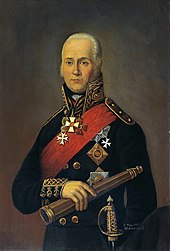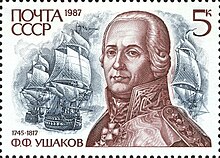Fyodor Fyodorovich Ushakov


Fyodor Ushakov ( Russian Фёдор Фёдорович Ушаков , scientific. Transliteration Fedor Fedorovic Ušakov ; February 13 jul. / February 24, 1745 greg. In Burnakowo , government Yaroslavl ; † October 2 jul. / 14. October 1817 greg. In Alexeyevka, Tambov Governorate ) was an admiral in the Russian fleet .
Life
Fyodor Ushakov was born into an impoverished Russian aristocratic family. His exact date of birth is not known, as all relevant files and documents have been destroyed. His parents were Paraskewa Nikititschna and Fyodor Ignatjewitsch Uschakow (1710–1781), sergeant of the Preobrazhensk bodyguard regiment . Ushakov uncle was Ivan Ignatievich Ushakov, who as Fyodor Sanaksarski, in the West (1718-1791) Theodor von Sanaksar , elder of Sanaksar monastery and later saint of the Russian Orthodox Church , has been known. On February 15, 1761 Ushakov joined the naval cadet corps in Saint Petersburg , where he studied the battles of the Dutch admiral Michiel de Ruyter and the maritime writings of Tsar Peter the Great .
After his studies, Ushakov served as an ensign in the Baltic galley fleet and later sailed with a transporter from Kronstadt to Arkhangelsk and back. In 1768 he was under the command of Rear Admiral Dmitry Senyavin the construction of the Don - flotilla in the Sea of Azov involved. Ushakov was promoted to lieutenant for his services . After that, he was on artillery - barges and a courier ship as artillery and naval officer used. In 1773 he received his first command of his own on the 16-gun ship Moreja . During the battles of the Azov flotilla against the Turks , Ushakov received his baptism of fire on June 28, 1774 on the 20-gun ship Modon .
In 1775 Ushakov was reassigned to the Baltic Fleet with the rank of lieutenant captain and took part in a trade expedition to the Mediterranean from 1776 to 1779 as commander of a frigate . In 1780 he became the commandant of the Tsar's yacht Standart , but did not feel comfortable in this position.
As early as 1781 he was therefore given command of the 64-gun ship of the line Viktor . Together with six other Russian combat ships, he was sent to Cádiz in the same year to protect Russian merchant ships . On January 1, 1782 Ushakov was promoted to "Captain 2nd Rank" (Russian term for frigate captain ). When Tsarina Catherine II ordered the construction of a fleet in the Black Sea after the annexation of Crimea to Russia , Ushakov marched with 3,900 men to Korsun (today Cherson ) to lay the foundations for the new fleet. Ushakov managed to protect his troops from the plague that raged in the area through the strictest hygiene measures .
In 1784 Ushakov was promoted to sea captain and was given command of the ship of the line Svyatoi Pawel . He attached great importance to the nautical and artillery training of his crew. During a shooting exercise in the presence of Tsarina Katharina II. And Emperor Joseph II. Ushakov became aware of the excellent shooting results of his artillerymen in the highest circles and he was able to present his views on the renewal of outdated naval warfare tactics. Ushakov's request to entrust him with command of the vanguard of the Black Sea Fleet is initially rejected by the fleet's commander, Prince Potjomkin .
With the outbreak of the war against Turkey in 1787 , Ushakov was given command of the vanguard of the Black Sea Fleet as a commodore . On July 14, 1788, he attacked the Turkish flagship with his four ships near the island of Fidonisi (east of the Danube estuary) and forced it to turn away. Since the Russian fleet commander Rear Admiral Woinovich did not intervene in the fight, the Russian victory was given away. However, since the Turkish fleet followed their damaged flagship, the Russians were able to record a tactical success: The Turkish fleet could not support the enclosed Turkish fortress of Ochakov . For his actions in front of Fidonisi, Ushakov was awarded the 3rd Order of Vladimir . He was appointed commander of the Sevastopol squadron and promoted to rear admiral in 1789.
In the same year Ushakov crossed the Turkish coast with his squadron and fired at u. a. the fortress of Sinope . On July 19, 1790, he defeated a superior Turkish landing fleet in the sea battle at Kerch and on August 28, 1790, a Turkish squadron in the sea battle at Tendra (northwestern Black Sea). For the victory at Tendra Uschakow was awarded the George II class and 500 serf farmers in the Mogilev governorate . On August 11, 1791, Ushakov succeeded in another victory over a Turkish fleet anchored there at Cape Kaliakra (northeast of Varna ).
After Napoléon Bonaparte's invasion of Turkish-administered Egypt in 1798 , the Russian Tsar Paul I (from 1796) and the Turkish Sultan Selim III joined forces . formed an alliance against the French and united their fleets in the Mediterranean. Commander-in-chief of the Russian-Turkish fleet, which left Constantinople on September 9, 1798 , was Ushakov, who had meanwhile risen to the rank of admiral, and who had received permission from the tsar to ally himself with the British fleet under Admiral Nelson . The order for the Russian-Turkish fleet was to protect the Albanian coast and to conquer the Ionian Islands occupied by France . The unification with the British failed because of the negative attitude of Nelson, who refused to accept orders from the Russian admiral, although Ushakov was higher in rank. But even without British help, the Russians and Turks managed to occupy the Ionian Islands. Ushakov called the Republic of the Seven Ionian Islands into being with a constitution he himself wrote based on the Venetian model and which was proclaimed on March 21, 1799. The region's nobles then sued Ushakov before the Tsar.
Most recently, Ushakov was able to conquer the heavily fortified island of Corfu on March 1, 1799 , whose French occupation he had honorably withdrawn, which earned him criticism from the Tsar. Since the Greek population of Corfu did not want to come under Turkish occupation, they placed themselves under the protection of the Russians, which led to tensions with their Turkish ally. Worried about Russia's successes, Great Britain sided with the Turks.
Meanwhile, Tsar Paul urged Ushakov to conquer the island of Malta . The Tsar had been Grand Master of the Order of Malta since December 16, 1798 . With Britain also interested in Malta, Nelson tried to thwart Russian intentions. He met Ushakov on August 25, 1799 in Palermo and asked him to actively support the beleaguered King Ferdinand I of Sicily and to take part in the smashing of the bourgeois-revolutionary Parthenopean Republic . Ushakov refused and asked Nelson for mercy for the prisoners.
In this situation, intrigues against Ushakov were already being spun in Petersburg. The not yet successful conquest of Malta, his behavior towards the French occupation of Corfu and the lawsuit over the establishment of the Republic of the Seven Ionian Islands weakened Ushakov's position considerably. In addition, on the advice of the British, the Turks left the joint fleet and returned to Turkey. After a Russian army from General Suvorov's army was crushed by the French, Tsar Paul I recalled the Russian Mediterranean fleet. Ushakov left Naples on December 31, 1799 and, interrupted by a necessary repair of his ships in Corfu, reached the port of Sevastopol on November 6, 1800. Ushakov was immediately ordered to St. Petersburg to answer for the allegations against him. With the assassination of Tsar Paul I on April 6, 1801, however, Russian interests changed. The new Tsar Alexander I thought of an alliance with Napoleon . A successful fighter against the French like Ushakov interfered with this. He was given the insignificant command of the Galley Association of the Baltic Fleet . Admiral Ushakov took his leave on December 30, 1806, disappointed. In the Patriotic War of 1812, however, Ushakov made himself available again. However, a serious illness forced him to give up all military activities.
After his death, Admiral Fyodor Ushakov was buried in the Sanaksar monastery near Temnikow .
Honors and canonization
The Ushakov order of the Soviet fleet is named after Ushakov . Several warships and the asteroid (3010) Ushakov also bear his name and the town of Brandenburg (Frisches Haff) was renamed after him in 1946.
In 2001 he was canonized by the Russian Orthodox Church . On the 15th anniversary of his canonization in 2016, his relics were laid with ecclesiastical and military ceremonies in the Kazan Cathedral in Saint Petersburg. The new Saransk Cathedral, completed in 2006, bears his name.
Also in 2006, the Ushakov memorial at Cape Kaliakra was inaugurated in Bulgaria .
literature
- Wolfgang Ehm, Dieter Flohr: They called him Uschak-Pascha. A picture of the life of the Russian admiral FF Uschakow , in: Marinekalender der DDR 1985. Berlin 1984
- Georgi Schtorm: Uschakow, Verlag der Nation, Berlin / GDR 1953
Movies
- Sails in the Storm ( Admiral Uschakow , USSR 1953, directed by Michail Romm ).
- Ships storm bastions ( Korabli schturmujut bastiony , USSR 1953, directed by Michail Romm).
Web links
Individual evidence
- ↑ Russia beyond the headlines , August 11, 2016
| personal data | |
|---|---|
| SURNAME | Ushakow, Fyodor Fyodorowitsch |
| ALTERNATIVE NAMES | Fëdor Fëdorovič Ušakov |
| BRIEF DESCRIPTION | Russian naval officer and admiral |
| DATE OF BIRTH | around 1745 |
| PLACE OF BIRTH | Burnakovo, Yaroslavl Governorate |
| DATE OF DEATH | October 14, 1817 |
| Place of death | Alexeyevka, Tambov Governorate |


